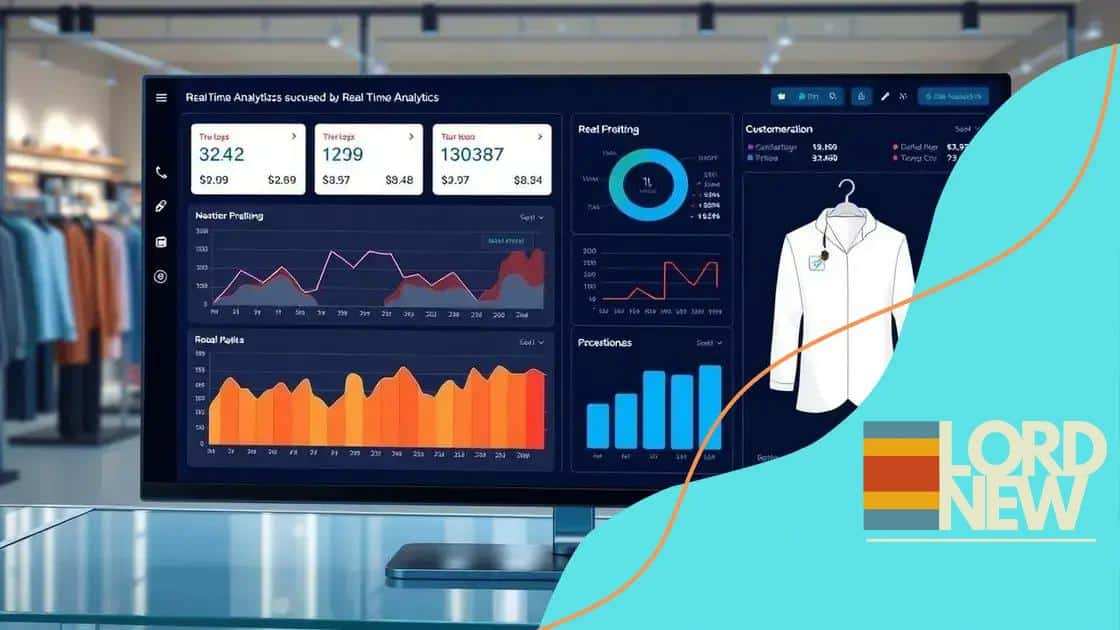Shein’s use of data analytics for pricing optimization

Shein’s use of data analytics for pricing optimization enables real-time price adjustments based on customer behavior, market trends, and demand fluctuations, enhancing competitiveness in the fast fashion industry.
Shein’s use of data analytics for pricing optimization has reshaped how retailers strategize in today’s market. Have you ever wondered how brands like Shein stay ahead in pricing? In this article, we’ll delve into their innovative approaches…
How data analytics transformed Shein’s pricing model
Data analytics has significantly impacted Shein’s pricing model, enabling the company to react swiftly to market trends and consumer behaviors. By leveraging intense analyses of data, Shein can determine the optimal price points for its products, ensuring both profitability and competitiveness.
Understanding customer preferences is a core aspect of Shein’s approach. Through data collection, they analyze shopping patterns, seasonal trends, and customer feedback, which informs their pricing strategies. This allows them to set prices that appeal to their target demographic, increasing sales and customer loyalty.
Real-time data impact
One of the key elements in Shein’s pricing success is the use of real-time data analytics. This technology enables the brand to:
- Adjust prices based on demand fluctuations.
- Identify the most profitable products.
- Make informed decisions quickly.
- Craft personalized marketing strategies.
With real-time insights, Shein places itself at the forefront of retail innovation. The company can swiftly respond to competitors and market changes, ensuring their prices remain attractive to consumers.
Dynamic pricing strategies
Dynamic pricing is another tactic that Shein employs. By utilizing advanced algorithms, they continuously analyze various factors including customer influx, inventory levels, and operational costs. This approach allows Shein to implement flexible pricing that adapts to market conditions.
Such techniques ensure that prices remain competitive, which in turn boosts customer engagement. Furthermore, customers are often rewarded with discounts or promotions based on their browsing history and interaction with the site. This not only enhances the shopping experience but also encourages repeat purchases.
As customers engage with Shein, their preferences and behaviors are tracked. This rich data reservoir informs future pricing decisions, allowing Shein to craft intricate pricing models tailored specifically for their audience.
Overall, the integration of data analytics into pricing strategies has revolutionized how Shein operates. By continuously adapting to customer needs and market fluctuations, they ensure they remain a preferred choice among fashion-forward shoppers.
Understanding customer behavior through analytics
Understanding customer behavior through analytics is essential for brands like Shein. By studying customer interactions, Shein captures insights that inform their marketing and pricing strategies.
Analytics help identify purchasing patterns and preferences. For instance, Shein analyzes data on what products are trending based on customer clicks and purchases. This analysis allows them to focus on high-demand items, enhancing inventory management.
Key insights from data
Through robust data collection, Shein gains a deeper understanding of their audience. The analytics provide:
- Insights into peak shopping times and trends.
- Information on demographic preferences, such as age and location.
- Customer feedback analysis, guiding product development.
- Behavior tracking to personalize marketing.
Utilizing this information allows Shein to create targeted promotions that resonate with their customers’ interests. By sending tailored offers, they increase conversion rates, resulting in more satisfied clients.
The role of segmentation
Customer segmentation is crucial in analyzing behavior. By dividing customers into groups, Shein can address individual needs effectively. Segmentation might consider factors like:
- Shopping frequency.
- Average order value.
- Preferred product categories.
- Response to marketing campaigns.
This level of analysis empowers Shein to craft meaningful marketing messages that connect with various customer segments. Engaging customers on a personal level builds loyalty and drives sales.
Moreover, examining customer feedback through surveys and reviews provides valuable information. Listening to customers helps Shein improve its offerings and adapt to changing preferences. This ongoing analysis creates a feedback loop that continually enhances the customer experience.
The role of real-time data in pricing strategies

The role of real-time data in pricing strategies is vital for companies like Shein. Real-time data allows Shein to stay competitive in the fast-paced fashion industry by enabling quick adjustments to pricing.
By using real-time data analytics, Shein tracks customer behavior as it happens. For example, she can monitor which items are being viewed or added to carts in real time. This information helps the company to identify trends and respond promptly to customer demand.
Dynamic pricing mechanisms
One way Shein utilizes real-time data is through dynamic pricing. This approach means that prices can change based on several factors, such as:
- Current inventory levels.
- Competition pricing.
- Demand fluctuations.
- Seasonal trends.
With dynamic pricing, Shein can offer discounts on items that are slow to sell or increase prices on popular items when demand rises. This flexibility boosts sales and maximizes revenue.
Customer engagement and loyalty
Real-time data also plays a critical role in enhancing customer engagement. By analyzing customer interactions in real time, Shein can tailor offers and promotions that resonate with individual shoppers. For instance, if a customer shows interest in a specific category, Shein can send personalized discounts right away.
This method not only encourages immediate purchases but also fosters customer loyalty. Customers appreciate personalized experiences, which enhance their connection to the brand.
Moreover, the ability to analyze data in real time helps Shein remain agile and responsive to market changes. If a new fashion trend emerges, Shein can adjust pricing and inventory strategy quickly to capitalize on the interest, ensuring they capture sales before competitors.
Comparing Shein’s pricing with competitors
Comparing Shein’s pricing with competitors is crucial in understanding its market position. Shein consistently evaluates how its prices stack up against other fashion retailers. This strategy allows them to maintain a competitive edge in the fast fashion industry.
Shein’s pricing model is often lower than that of its competitors, thanks to direct sourcing and efficient supply chain management. By removing middlemen and working closely with manufacturers, Shein reduces costs and can offer affordable prices to consumers.
Price comparisons with major competitors
When comparing Shein’s pricing structure to brands like Zara, H&M, and Forever 21, several factors stand out:
- Product Variety: Shein offers a broader range of styles, often at lower price points.
- Frequency of Sales: Shein frequently runs promotions, providing discounts that attract price-sensitive shoppers.
- Response to Trends: Shein quickly adapts to fashion trends, ensuring new items are available at competitive prices.
- Shipping Costs: Shein’s shipping policies often favor affordability, sometimes offering free shipping for minimum purchases.
By examining these aspects, it becomes clear why many consumers prefer Shein over other retailers. The combination of lower prices and trendy offerings creates a strong appeal.
Impact on market share
The aggressive pricing strategy has helped Shein capture a significant market share. As consumers continue to look for stylish clothing at reasonable prices, Shein’s approach resonates well. Their ability to launch new products rapidly means they often outpace competitors in capturing consumer interest.
Additionally, Shein employs data analytics to continually assess its pricing strategies against competitors. By doing this, they can modify prices quickly to ensure they remain attractive. This practice not only enhances customer satisfaction but also fosters loyalty.
Ultimately, Shein’s efficient pricing strategy and focus on customer preferences set it apart in a crowded market. This commitment to competitive pricing continues to drive its growth in the fast fashion sector.
Future trends in data analytics for pricing optimization
Future trends in data analytics for pricing optimization promise to transform how companies like Shein strategize their pricing models. As technology evolves, the ability to predict customer needs and market changes becomes more refined.
One key trend is the increased use of artificial intelligence in pricing strategies. AI algorithms can analyze vast amounts of data, identifying patterns that humans might overlook. This capability allows companies to set prices that maximize profit while remaining attractive to consumers.
Predictive analytics
Predictive analytics is another trend gaining traction. By utilizing historical data, businesses can forecast future pricing trends more accurately. This method helps companies anticipate shifts in consumer behavior, ensuring they adjust prices proactively rather than reactively.
- Understanding buying cycles helps businesses tailor promotions.
- Customer segmentation allows for tailored pricing strategies.
- Real-time feedback loops enhance responsiveness to changes.
Employing predictive analytics not only enhances pricing strategies but also supports inventory management by aligning product availability with anticipated demand.
Personalization in pricing
Another emerging trend is the personalization of pricing based on customer data. Brands like Shein can use analytics to offer customized discounts based on individual shopping history. This targeted approach increases customer satisfaction and loyalty.
For instance, a shopper who frequently buys casual wear may receive special pricing on new arrivals in this category. Such personalized pricing creates a more engaging shopping experience and encourages repeat purchases.
Moreover, integrating social media data into pricing strategies allows brands to respond to trends directly influenced by customer conversations. By analyzing what customers are saying online, companies can adjust prices and offerings to align with current interests, ensuring they stay relevant in the marketplace.
FAQ – Frequently Asked Questions about Shein’s Pricing Optimization and Data Analytics
How does data analytics help Shein optimize its pricing strategies?
Data analytics provides insights into customer behavior, market trends, and demand fluctuations, allowing Shein to set competitive prices.
What is dynamic pricing, and how does Shein use it?
Dynamic pricing allows Shein to adjust prices in real time based on factors like inventory levels and competition, maximizing sales and profits.
How does Shein personalize pricing for customers?
Shein uses customer data to offer targeted discounts and promotions, enhancing customer engagement and loyalty.
What future trends should we expect in data analytics for pricing?
Future trends include increased use of AI and predictive analytics to forecast customer behavior and refine pricing strategies.





